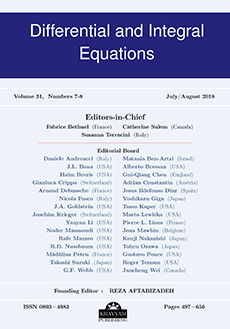Abstract
We study the problems $$ \begin{array}{lcr} -\Delta u= f_{\theta}(u)\text{ in }\Omega, & & u=0\text{ on }\partial\Omega,\\ -\Delta u + u= f_\theta(u)\text{ in }\Omega, & & \partial_{\nu} u=0\text{ on }\partial\Omega, \end{array} $$ where $f_{\theta}$ is a slowly superlinearly growing nonlinearity, and $\Omega$ is a bounded domain. Namely, we are interested in generalizing the results obtained in [4], where the model nonlinearity $f_\theta(u)= | {u} | ^{\theta-2} u$ was considered in the case of Dirichlet boundary conditions. We derive the asymptotic behaviour of ground state and least energy nodal solutions when $\theta\to 2$, leading to symmetry results for $\theta$ small. Our assumptions permit us to study some typical nonlinearities such as a superlinear perturbation of a small pure power or the sum of small powers and slowly exponentialy growing nonlinearities in dimension $2$.
Citation
Denis Bonheure. Vincent Bouchez. Christopher Grumiau. "Asymptotics and symmetries of ground-state and least energy nodal solutions for boundary-value problems with slowly growing superlinearities." Differential Integral Equations 22 (9/10) 1047 - 1074, September/October 2009. https://doi.org/10.57262/die/1356019522
Information





